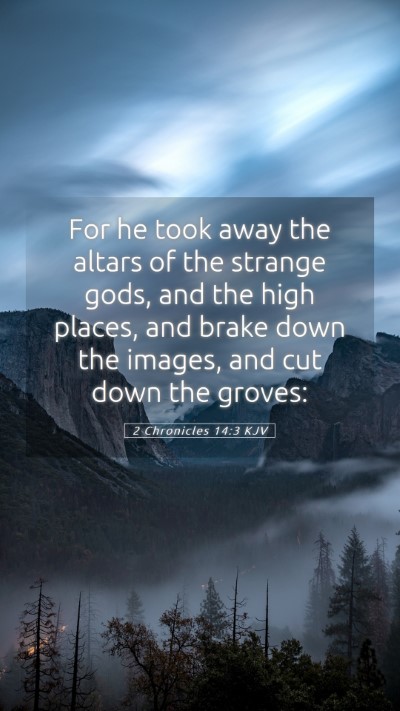Bible Verse Meaning: 2 Chronicles 14:3
Verse: "For he took away the altars of the strange gods, and the high places, and brake down the images, and cut down the groves." (2 Chronicles 14:3)
This verse encapsulates a crucial moment in the reign of King Asa of Judah, highlighting his commitment to spiritual reform and the worship of Yahweh alone. Below, we explore the significance of this action through various biblical commentaries.
Analysis of 2 Chronicles 14:3
According to Matthew Henry, this verse signifies King Asa’s determination to eradicate idolatry from the land of Judah. He recognized that the altars and high places were not merely physical structures, but symbols of a spiritual decline that had tainted the nation. Asa's actions represented a necessary return to the worship of the One True God, and his decisions serve as a template for spiritual leadership.
Albert Barnes elaborates on the cultural context by noting that high places were often sites of pagan worship, which had infiltrated Israelite tradition. By removing these altars, Asa sought to purify the worship of God, reflecting a critical moment of reform that aimed to revive the faith among the Israelites. His actions demonstrate the importance of aligning national practices with the commandments of God.
Adam Clarke provides further insight into the significance of cutting down the groves and breaking the images. He emphasizes that such actions were dangerous yet necessary, posing Asa as a king who would not shy away from confronting the influences of surrounding pagan cultures. This bold stance against idolatry underscores Asa’s role not only as a ruler but as a reformer committed to reinstating genuine worship among his people.
Key Themes and Insights
- Spiritual Reform: Asa’s actions depict the need for repairing one’s relationship with God through removing obstacles that lead to idolatry.
- Leadership and Responsibility: As a king, Asa exemplifies the weight of responsibility leaders have in guiding their people towards righteous behavior.
- Historical Context: Understanding the background of pagan practices in Judah is crucial for grasping the radical nature of Asa’s reforms.
- Consequences of Idolatry: The removal of these altars highlights the destructive nature of idolatry and the necessity of worshiping God in purity.
Learning and Application
For modern believers, 2 Chronicles 14:3 carries lessons about the importance of prioritizing one’s devotion to God. In today's context, it prompts questions such as:
- What are the modern-day 'altars' that distract us from our worship of God?
- How can we actively remove influences that lead us away from our faith?
- In what ways can we ensure our worship remains focused on the true essence of our beliefs?
Bible Study Insights
This verse can serve as a powerful starting point for Bible study groups or online Bible study sessions. Exploring Asa’s leadership can be an entry point for discussions about spiritual renewal, the importance of community worship, and the challenges of living out one’s faith in a secular culture.
Cross References
- 1 Kings 15:14 - Shows Asa's commitment to following the Lord.
- 2 Kings 18:4 - Discusses reforms made by King Hezekiah, drawing parallels between Asa and Hezekiah.
- 2 Chronicles 34:3 - King Josiah also undertakes reforms, emphasizing a theme of restoration in Judah.
Conclusion
In summary, 2 Chronicles 14:3 is not merely a historical account, but a profound lesson in spiritual integrity and the necessity of removing distractions from our worship. Whether approaching this text for Bible verse interpretations or deeper Scripture analysis, believers can find direction and encouragement to seek a purer relationship with God through the examples set by Asa.


